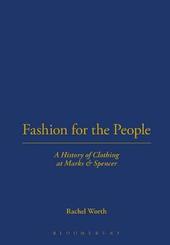
|
Fashion for the People: A History of Clothing at Marks & Spencer
Paperback / softback
Main Details
| Title |
Fashion for the People: A History of Clothing at Marks & Spencer
|
| Authors and Contributors |
By (author) Rachel Worth
|
| Physical Properties |
| Format:Paperback / softback | | Pages:168 | | Dimensions(mm): Height 244,Width 172 |
|
| Category/Genre | Fashion design and theory |
|---|
| ISBN/Barcode |
9781845201746
|
| Classifications | Dewey:391 |
|---|
| Audience | | Tertiary Education (US: College) | | Professional & Vocational | |
|---|
| Illustrations |
30 b&w illustrations, bibliography, index
|
|
Publishing Details |
| Publisher |
Bloomsbury Publishing PLC
|
| Imprint |
Berg Publishers
|
| Publication Date |
1 December 2006 |
| Publication Country |
United Kingdom
|
Description
Marks and Spencer is an English institution synonymous with quality, reliability and customer care. But do we associate it with 'fashion'? Clothing the People considers the company's contribution to British - and, since the 1970s, international - fashion, drawing on previously unpublished company archives and employee interviews. Over the past century, MS has become known for bringing high fashion to the high street, offering well-designed clothing at affordable prices. The author analyzes the unique ways in which MS has democratized fashion - from its pioneering role in the application of new technology and the development of fabrics, to its marketing and promotional strategies. She examines the difficulties MS faced in the late 1990s and early twenty-first century and looks at its plans for rejuvenation in the future. MS is not just a stalwart of the British high street. As this book shows, it has also brought fashion to the masses.
Author Biography
Rachel Worth is Principal Lecturer in Fashion Studies at the Arts Institute at Bournemouth.
Reviews'Makes a significant contribution to the discussion of fashion as a business process, connecting production, retail and consumption. The author also succeeds in suggesting important ways in which the nature of high street fashion can be understood - and the industry itself seen in a more subtle and complex way - rather than simply in terms of high fashion.' Rebecca Arnold, Central St. Martins College of Art and Design
|